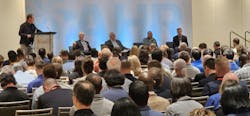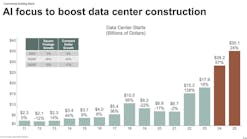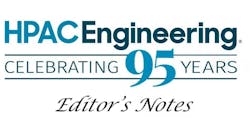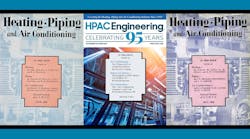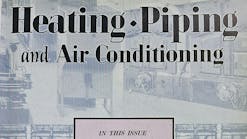Even as we approach a winter decidedly more upbeat economically than just a year ago, world events once again have intervened to restrain our optimism.
Undoubtedly history will remember the fourth quarter of 2023 more for a ghastly new war in the Middle East than it will for declining inflation, improved supply chains and a quietly miraculous escape from an all-but-certain recession. Similarly, continuing war in Ukraine and bombastic dysfunction in Washington have overshadowed our resilient return to a post-pandemic normal.
But good news is still out there. And there may be more of it than you realize.
Indeed, on Nov. 17, Dodge Construction Network released its forecast for 2024, and chief economist Richard Branch is now predicting a 7% increase in construction starts next year. Bolstered by federal stimulus funds for domestic manufacturing projects and continued infrastructure investment, Dodge expects total starts will surpass $1.2 trillion in 2024.
In particular, manufacturing starts will lead the way with a 16% annual increase, said Branch, adding that is “not a surprise, considering the impact of the CHIP and Inflation Reduction Acts.”
Also on the good news front, our own Larry Clark recently noted some silver linings in the climate clouds. Citing a new update to the International Energy Agency (IEA) report, Net Zero by 2050, A Roadmap for the Global Energy Sector, Clark writes, "The IEA has given us a glimmer of hope." The update states:
Positive developments over the past two years include solar PV installations and electric car sales tracking in line with the milestones set out for them in our 2021 Net Zero by 2050 report. In response to the pandemic and the global energy crisis triggered by Russia’s invasion of Ukraine, governments around the world announced a raft of measures designed to promote the uptake of a range of clean energy technologies. Industry is ramping up quickly to supply many of them. If fully implemented, currently announced manufacturing capacity expansions for solar PV and batteries would be sufficient to meet demand by 2030 in this update of the NZE scenario.
Such surprisingly good news was also cited at ASHRAE's Decarbonization Conference for the Built Environment, held in Washington in late October. There, keynote speaker and veteran journalist Chris Turner, author of the book, How To Be a Climate Optimist, told the assembled stakeholders, "This global energy transition, now emergent, now genuinely global in scale and scope, is also increasingly inevitable, with a momentum that continues to build with staggering speed by the day... It really is an extraordinarily powerful and inspirational moment."
Turner will be bringing that inspiration and urgent optimism to Chicago in January for the ASHRAE 2024 Winter Conference, which will be emphasizing the Society's newly accelerated and global decarbonization efforts. Young engineers, in particular, are being encouraged to make their voice heard, and so far, they are responding.
####
In Case You Missed It
On Oct. 29, CBS News '60 Minutes' ran a 14-minute segment entitled "The Air We Breathe." It is available on YouTube and worth seeing.
The show spoke with two experts familiar to HPAC readers, Dr. Linsey Marr, P.E., of Virginia Tech, and Dr. Joseph Allen, of Harvard University’s T.H. Chan School of Public Health. They discussed how IAQ was left out of discussions at the outset of the Coronavirus pandemic and how that compounded the tragedy that followed.
“Think about the early days of the pandemic, with ‘flatten the curve’—’stay home’,” recalled Allen. “Why wasn’t ‘Improve indoor air quality’ part of ‘flatten the curve’? We had tools to protect ourselves. Masking? Great tool, it's a filter. But we ignored the building side of this.”
Now, there is hope and real evidence that building owners and designers have learned those lessons, and are adjusting accordingly.
Yes, that qualifies as more actual hope for the holidays!
